Research Article - (2023) Volume 14, Issue 9
Received: 04-Aug-2023, Manuscript No. AASRFC-23-17330; Editor assigned: 09-Aug-2023, Pre QC No. AASRFC-23-17330 (PQ); Reviewed: 23-Aug-2023, QC No. AASRFC-23-17330; Revised: 31-Aug-2023, Manuscript No. AASRFC-23-17330 (R); Published: 28-Sep-2023
Background: The present meta-analysis aimed to assess if the anosmia and dysgeusia signs to obligate PCR (COVID-19) test and to Identity the prevalence of anosmia and dysgeusia in Saudi patients with a positive COVID-19 test and if there is relationship between the gender and prevalence.
Materials and methods: Meta-analysis were done using a restricted maximum likelihood estimator model to yield a point estimate and 95% CI for each subgroup analyzed, with a random effect for each study. The Preferred Reporting Items for Systematic Reviews and Meta-Analysis (PRISMA) reporting guideline was followed. Electronic databases (Proquest, Medline, Embase, Pubmed, CINAHL, Wiley online library and Nature) were searched from 1 January 2020 to 31 December 2021.
Results: Overall, 10 studies were identified in this meta analysis. Firstly, regarding the prevalence of anosmia and dysgeusia, six studies were included, 1374 patients suffered from dysgeusia and 1329 patients suffered from anosmia. The results showed significance between anosmia and dysgeusia (p<0.00001) with high variation of selected studies in heterogeneity by 98% in addition to chi square value of 202.53 and finally, patients with anosmia were higher by 1.62-folds than with dysgeusia. Secondly, concerning prevalence in gender, ten studies were concluded; number of females was 1899 compared with number of males 2194. There was significant difference between them (p<0.00001) which is confirmed by hetergeneity of 96% of very high variation among studies and chi square value as well, 213.4. The prevalence in females was higher by 0.77-folds than in males.
Conclusion: Anosmia and dysgeusia are prevalent in COVID-19 Saudi patients but the result showed high prevalence of Anosmia in patients than dysgeusia to obligate PCR (COVID-19) test. Moreover, females showed high prevalence than males concerning the COVID-19 obligation to PCR.
Anosmia; Dysgeusia; Loss of taste; Loss of smell; COVID-19
In December 2019, a series of severe atypical diseases appeared in the Chinese city. This speed travels from Wuhan to alternative regions. It was soon discovered that a completely unique coronavirus was to blame. The new coronavirus has been named coronavirus with severe acute metabolic syndrome 2 (SARS-CoV-2, 2019-nCoV) because of its high similarity (about 80%) to SARS-CoVs, which causes Acute Respiratory Distress Syndrome (ARDS) and a high level of mortality rate in 2002-2003. The SARS-CoV-2 outbreak is believed to have started with the transmission of an animal disease linked to a food market in Wuhan, China. Later, it was recognized that human-to-human transmission competes with a major role in the subsequent outbreak. The disease caused by this virus was known as Coronavirus Disease 19 (COVID-19) and the outbreak was declared by the World Health Organization (WHO) [1].
The COVID-19 virus has affected a wide range of individuals around the world, according to nearly two hundred countries and territories. As of the seventh Gregorian month, 2020, nearly 1,400,000 cases have been reported worldwide by Middle for Systems Science and Engineering (CSSE) at Johns- Hopkins university. Common symptoms of COVID-19 are general malaise, fever, cough and difficulty breathing. Alternative symptoms include muscle and joint pain, sore throat, headache, nausea or vomiting, diarrhea and some nasal symptoms, especially anosmia and style imbalance. Loss of anosmia may be a common symptom in patients with COVID-19, such as a urinary tract infection, respiratory illness, or the flu. However, sudden, severe, and isolated loss of anosmia and/or dysgeusia may also be an advantage in asymptomatic patients with COVID-19 [2,3].
This assumption has been clarified by various reports. However, it has not yet been validated in large-scale studies. A recent study showed that the viral load detected in asymptomatic patients was similar to the viral load of symptomatic patients, indicating that asymptomatic patients can also transmit the disease. The fact that there is a group of asymptomatic carriers roaming around is unrecognized and may be able to transmit the disease poses a serious public health threat if it is not identified and contained early on. Identifying asymptomatic carriers early will help us understand the dynamics [4].
In Germany, more than half of COVID-19 positive cases had anosmia and dysgeusia. Results of a study that was held on the university hospital of Sassari, university hospital of Salerno, and Bologna Maggiore-Bellaria hospital indicated that during the epidemic of COVID-19, flow or relapsed chemosensitivity dysfunction were accounted for by 21 (out of 33) patients. Of these, 13 patients (39.4%) detailed consolidated gustatory and olfactory issue, four patients (12.1%) showed isolated decrease in dysgeusia and segregated hypo/anosmia was accounted for in the other four patients (12.1%). In correlation, (11 out of 21 patients; 52.4%) announced a total relapse of chemosensitivity manifestations [5].
The aim of the study is to investigate whether anosmia and dysgeusia signs to obligate PCR test and to identify the prevalence of anosmia and dysgeusia in Saudi patients with a positive COVID-19 test and if there is relationship between the gender and prevalence.
Registration and Protocol
To comprehensively calculate the cumulative prevalence of anosmia and dysgeusia in COVID-19 prevalence in kingdom of Saudi Arabia, a systematic review was conducted following guideline of Preferred Reporting Items zfor Systematic Reviews and Meta-Analyses (PRISMA) [6].
Information Sources and Search Strategy
Studies on SARS-CoV-2 or COVID-19 have been included. To find relevant original articles, a comprehensive database search was conducted, consulting Medline through PubMed, EMBASE and Web of Science, and the following keywords was used: Anosmia, dysgeusia, loss of smell, loss of taste, COVID-19.
Study Selection and Data Extraction
The inclusion criteria was: Studies conducted in Saudi Arabia and in adults of all ages (more than 17 years old) with positive PCR tests. And shows the prevalence of anosmia and dysgeusia. Any study that was not eligible for the inclusion criteria was excluded. Number of studies were pooled with 95% Confidence Intervals (CIs) .Information of study characteristics, number of patients suffering loss of smell and taste besides prevalence of gender [7].
Data Synthesis
In selected six studies, the prevalence rate of anosmia and dysgeusia was calculated for COVID-19 cases by dividing the number of COVID-19 cases with anosmia by the total number of COVID-19 cases with and without anosmia, and was expressed as a percentage (%) with 95% confidence intervals (95% CI). Pooled Odds Ratios (OR) and 95% CI were calculated to assess the association of anosmia, dysgeusia and the occurrence of SARS-CoV-2. The same method was used for dysgeusia (Table 1). The pooled OR and 95% CI were presented in a forest plot and funnel plot [8].
| Name of study | Pt no. | Anosmia % | Anosmia | Pt no. | Dysgeusia% | Dysgeusia |
|---|---|---|---|---|---|---|
| AlShakhs et al., 2020 | 274 | 65 | 179 | 274 | 64 | 175 |
| Algahtani et al., 2021 | 881 | 73 | 639 | 881 | 65 | 572 |
| Alqurashi et al., 2021 | 380 | 12 | 47 | 380 | 2 | 7 |
| Bayomy et al., 2020 | 428 | 13 | 56 | 428 | 6 | 25 |
| Bin Abdulrahman et al., 2021 | 223 | 33 | 74 | 223 | 31 | 70 |
| Mubaraki et al., 2021 | 1022 | 33 | 334 | 1022 | 51 | 525 |
Table 1: Prevalence of anosmia and dysgeusia in Saudi patients.
The synthesis of data was identically applied to gender prevalence as well supplied with CIs 95%, OR (Table 2).
| Name of study | Male no. | Female no. | Total |
|---|---|---|---|
| AlShakhs et al., 2020 | 124 | 150 | 274 |
| Alshami et al., 2020 | 59 | 69 | 128 |
| Algahtani et al., 2021 | 363 | 445 | 881 |
| Alqurashi et al., 2021 | 117 | 98 | 380 |
| Bayomy et al., 2020 | 230 | 198 | 428 |
| Bin Abdulrahman et al., 2021 | 156 | 67 | 223 |
| Mubaraki et al., 2021 | 622 | 400 | 1022 |
| Kamel et al., 2020 | 180 | 117 | 375 |
| Issa et al., 2021 | 220 | 280 | 500 |
| Alshehri et al., 2021 | 123 | 75 | 198 |
Table 2: Prevalence of anosmia and dysgeusia based on gender.
Statistical Analysis
Meta-analysis was conducted through the Revman 5.4 software. Heterogeneity was evaluated by calculating the I2 index. I2 values less than 25%, 25%-50%, 50%-75% and 75%-100% were homogeneous, or had low, medium, and high heterogeneity levels, respectively. The Random Effect Model (REM) was applied if the I2 value is >50%. 95% Confidence Intervals (CI) were used to assess the relationship between liver dysfunction and COVID-19. The sensitivity analysis was repeated to evaluate the impact of each study in the analysis by subsequently excluding different individual studies each time.
Study Processing
Thirty relevant articles were identified. Inclusion criteria was applied and as if the anosmia and dysgeusia signs to obligate PCR test were assessed and thus six research papers were included to test that prevalence among COVID-19 positive Saudi patients but for gender prevalence, total of ten studies were in the meta analysis [9].
Literature Search
A total 10 studies were included (Figure 1 for the flow records). For anosmia and dysgeusia, only six studies were included. And for gender prevalence 10 studies were chosen.
Study Characteristics
The publications were published between 2020 and 2021. All publications were applied in Saudi Arabia. The selected publications followed the criteria used to be applied on anosmia, dysgeusia, besides PCR test for patients.
Study Selection
All records retrieved from the database searches were imported into revman 5.4. duplicates were removed before titles and abstracts were screened independently by two authors, coding articles as provisionally eligible or excluded according to the inclusion and exclusion criteria. Afterwards, full texts were screened independently and coded as eligible or excluded. A PRISMA flow diagram documents the flow of records [10].
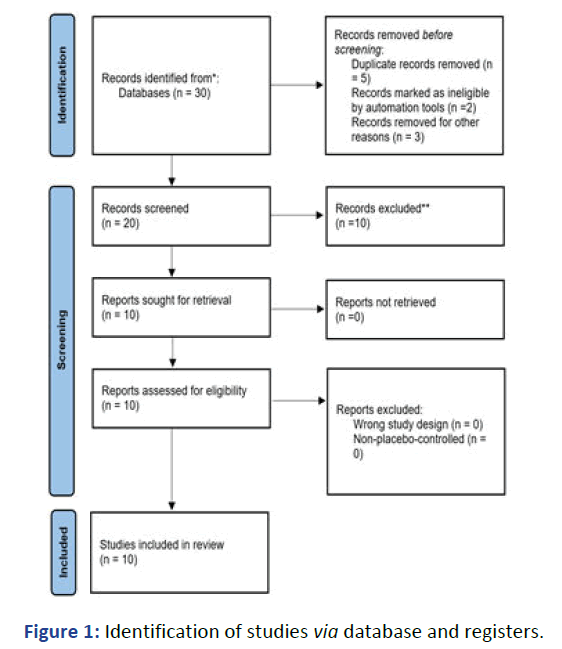
Figure 1: Identification of studies via database and registers.
Effect of COVID-19 on Anosmia and Dysgeusia to Obligate PCR
A total of 6 studies were included in the analysis. The observed odds ratios ranged from 0.92 to 2.18. The average odds ratio based on the random-effects model was =1.62 (95% CI: 1.46 to 1.79). Therefore, the average outcome did differ significantly from zero (z=9.06, p<0.00001). According to the Chi square-test, the true outcomes appear to be heterogeneous (Q(5)=202.53, p<0.00001, I²=98%). One study had a value larger than ± 2.6383 and may be a potential outlier in the context of this model (Figure 2).
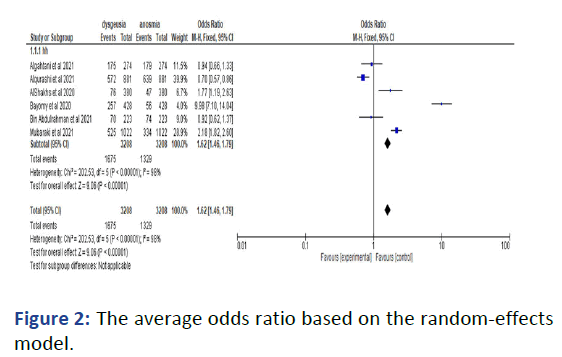
Figure 2: The average odds ratio based on the random-effects model.
The funnel plot (Figure 3) showed asymmetrical distribution of the studies which confirms this study’s output of heterogeneity or any correlation among studies.
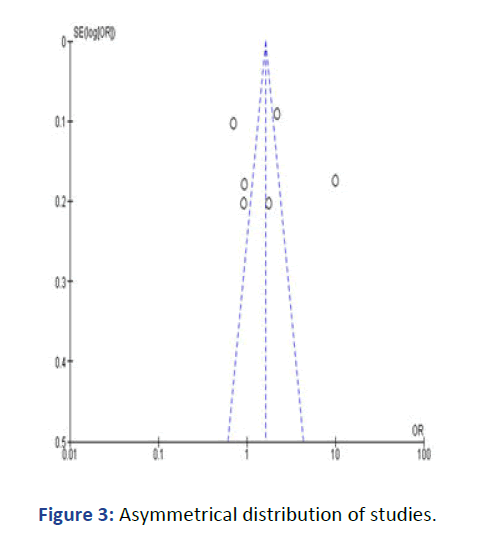
Figure 3: Asymmetrical distribution of studies.
Prevalence of Anosmia and Dysgeusia Based on Gender
A total of 10 studies were included in the analysis. The observed odds ratios ranged from 0.18 to 1.62. The average odds ratio based on the random-effects model was =0.77 (95% CI: 0.7 to 0.83). Therefore, the average outcome did differ significantly from zero (z=6.27, p<0.00001). According to the Chi square-test, the true outcomes appear to be heterogeneous (Q(9)=213.4, p<0.00001, I²=96%) (Figure 4).
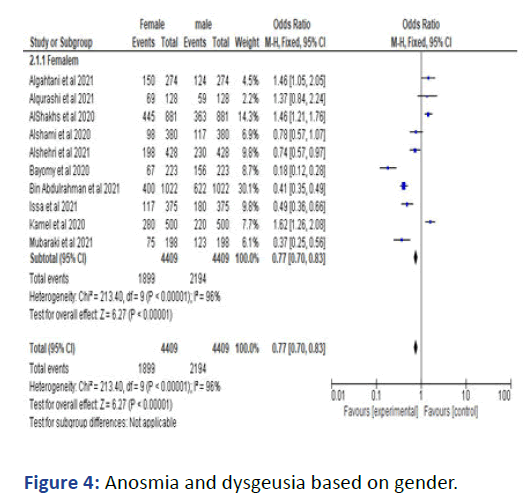
Figure 4: Anosmia and dysgeusia based on gender.
The funnel plot (Figure 5) showed asymmetrical distribution of the studies which confirms this study’s output of heterogeneity or any correlation among studies.
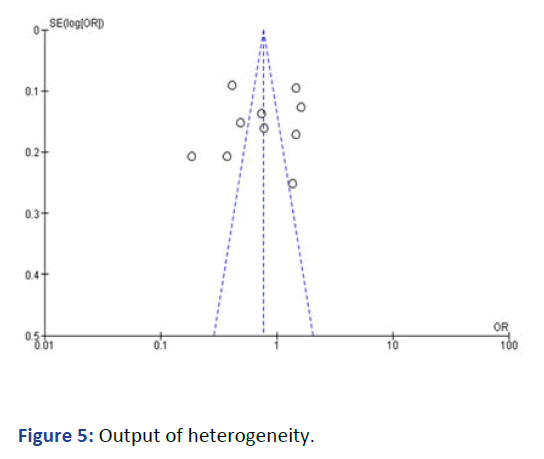
Figure 5: Output of heterogeneity.
Coronavirus Disease 2019 (COVID-19) may be an infection caused by the novel virus Severe Acute Respiratory Syndrome Coronavirus 2 (SARS-CoV-2). On the 11th March 2020, the World Health Organization (WHO) declared COVID-19 a global pandemic that emerged from East Asia and quickly spreads to the rest of the world as it is responsible for more than 350,000 deaths worldwide [11].
The clinical symptoms of coronavirus disease 2019 have shown a plain variability from asymptomatic carriers to patients with Acute Respiratory Distress Syndrome (ARDS) that would cause death. However, most patients experience mild to moderate manifestations, like fever, cough, dyspnea, myalgia, fatigue, sputum production, arthralgia, headache, diarrhea, rhinorrhea and sore throat.
Prevalence Loss of Anosmia and Dysgeusia in COVID-19 Patients
The pooled prevalence of loss of anosmia and dysgeusia in this systematic review was 100% of COVID-19 cases. This confirms they could be potential indicator of SARS-CoV-2 infection, and may be useful for screening and early identification of COIVD-19 patients, particularly in patients without common COVID-19 symptoms such as fever and cough. This study demonstrated that the prevalence of anosmia was 1.62-fold higher than dysgeusia of COVID-19 patient. A study showed this result and affirmed the study’s findings as well as.
A Meta-analysis of 29,349 patients on prevalence and characteristics of taste disorders in cases of COVID-19 showed that The prevalence of taste disorders in studies with objective assessments was higher as compared with subjective assessments (59.2% vs. 47.3%). The disorders were determined in 55.2% of European patients; 61.0%, North American; 27.1%, Asian; 29.5%, South American and 25.0%, Australian. Ageusia, hypogeusia and dysgeusia were detected in 28.0%, 33.5% and 41.3% of patients with COVID-19. The study a bent to known 91.5% of the inclosed studies as high quality [12,13].
Anosmia and Dysgeusia in Patients Based on Gender
A retrospective cohort study, published in the American journal of gastroenterology, February 2021, was a retrospective cohort study of 130 consecutive adult patients with a positive COVID PCR test admitted from March 16 May 14, 2020 at a tertiary care university hospital. Anosmia and or dysgeusia was more likely to be prevalent in women with COVID-19 as compared to men. The results in this study met the previous studies as the prevalence of anosmia and or dysgeusia is 0.77-fold in women to males and thus supposed to influence the immunity system to this findings as well [14,15].
Female participant with SARS-CoV-2 antibodies and unresolved odor loss and unresolved taste loss were significantly older (>40 years) than those reporting complete resolution. Those who experience Anosmia (a distortion of smell) recover smell recovery rates and those who experience distorted taste perception recover taste recovery rates less effectively. Anosmia was found to be strongly associated with unresolved smell loss (or 2.47, 95% CI 1.54-4.00, p<0.001).
The goals of the study are to identify the prevalence of anosmia and dysgeusia. And to examine if anosmia and dysgeusia obligate PCR test in Saudi. In addition to whether gender affects significantly. Both anosmia and dysgeusia had prevalence 100% in patients that had COVID-19 which is a key indicator of COVID-19 infection. Moreover, anosmia had 1.62- fold higher than dysgeusia in all studies than in those who did not. In those who had COVID-19, it was obligate to make PCR. After all, all these results confirmed the relationship between anosmia, dysgeusia and COVID-19 PCR tests which is considered a mandatory in this meta-analysis final conclusion.
Prevalence of loss and taste according to gender was obvious in females than males by 0.77-fold of OR. Thus, The variation in results concerning the heterogeneity showed that all studies confirmed that the loss of anosmia and dysgeusia are related with COVID-19 infection and, as a result, PCR test should be performed where they are indicators for positive status as explained previously.
I am very thankfully appreciating the contribution and the effort of all the people who helped us in this research. Also the author would like to thank the deanship of scientific research at Umm Al-Qura university for supporting this work by grant code:
[Crossref] [Google Scholar] [PubMed]
[Crossref] [Google Scholar] [PubMed]
[Crossref] [Google Scholar] [PubMed]
[Crossref] [Google Scholar] [PubMed]
[Crossref] [Google Scholar] [PubMed]
[Crossref] [Google Scholar] [PubMed]
[Crossref] [Google Scholar] [PubMed]
[Crossref] [Google Scholar] [PubMed]
[Crossref] [Google Scholar] [PubMed]
[Crossref] [Google Scholar] [PubMed]
[Crossref] [Google Scholar] [PubMed]
[Crossref] [Google Scholar] [PubMed]
[Crossref] [Google Scholar] [PubMed]
[Crossref] [Google Scholar] [PubMed]
[Crossref] [Google Scholar] [PubMed]
Citation: Shammah AA, Alasmari BA, Alfakeeh GA, Azizalrahman RW (2023) The Prevalence of Anosmia and Dysgeusia in Positive COVID-19 Adult Saudi Patients during 2020-2021: Meta-Analysis. Adv Appl Sci Res. 14:112.
Copyright: © 2023 Shammah AA, et al. This is an open-access article distributed under the terms of the Creative Commons Attribution License, which permits unrestricted use, distribution, and reproduction in any medium, provided the original author and source are credited.